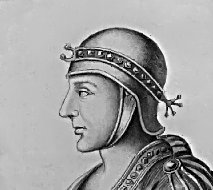 arold II (?1022-1066), king of the English,
second son of Earl Godwin, shared in his father’s banishment
(1051) and restoration, and on Godwin’s death (1053) became
earl of Wessex. In 1066 he was nominated by the English King as
his successor, and on the King’s death was elected by the
nobles. Thereupon William of Normandy invaded England. Harold,
first defeating Harold of Norway and his own brother Tostig at
Stamford Bridge in Yorkshire, marched against William, and at the
Battle of Hastings was overthrown and slain. [World Wide
Illustrated Encyclopedia, 1935]
arold II (?1022-1066), king of the English,
second son of Earl Godwin, shared in his father’s banishment
(1051) and restoration, and on Godwin’s death (1053) became
earl of Wessex. In 1066 he was nominated by the English King as
his successor, and on the King’s death was elected by the
nobles. Thereupon William of Normandy invaded England. Harold,
first defeating Harold of Norway and his own brother Tostig at
Stamford Bridge in Yorkshire, marched against William, and at the
Battle of Hastings was overthrown and slain. [World Wide
Illustrated Encyclopedia, 1935]
Notes on King Harold II
Appointed Earl of the East Angles before 1045; succeeded his
father as Earl of the West SAXONS in 1053. The Witan confirmed
the choice of Edward II as his successor, he was crowned Jan 1066.
In Sep 1066, England was invaded north of the Humber by Harold
HARDRADA, King of Norway. On 25 Sep 1066, he destroyed the
Norwegian Army at Stamford Bridge. Harold then hurried South to
meet the invasion of William, Duke of Normandy, and gave battle
on Senlac, a hill near Battle (described by chroniclers as
Hastings, near where William came ashore). Harold’s army
fell fighting gloriously against the Norman invaders. Harold was
reputedly killed by an arrow through his eye. Harold’s body
was buried under a cairn on the sea-shore and thence taken to
Waltham Abbey. {Burke’s Peerage and Chamber’s
Biographical Dictionary} [GADD.GED]
 Harold II (1020?-1066), king
of England (January 6, 1066-October 14, 1066), last of the Saxon
rulers, and a capable military leader.
Harold II (1020?-1066), king
of England (January 6, 1066-October 14, 1066), last of the Saxon
rulers, and a capable military leader.
The second son of Godwin, earl of Wessex, Harold was made earl
of East Anglia in 1045. In 1051 Godwin lost the favor of King
Edward the Confessor and was exiled with his sons, but the
following year the lands and titles of the family were restored
in order to strengthen the security of the country. In 1053
Harold succeeded his father as earl of Wessex, becoming chief
minister to King Edward and the most powerful man in the realm.
Through his efforts, the warlike Welsh were subdued in 1063.
After a revolt against Harold's brother Tostig, earl of
Northumbria, Harold was forced to banish Tostig, an action that
managed to restore peace but created a bitter enmity between the
two brothers.
Probably in 1064, Harold was shipwrecked off the coast of
Normandy and captured by William, duke of Normandy. As a
condition of his release, Harold was forced to swear his
allegiance to William and his claim for the English throne, and
he returned to England unharmed. When King Edward was dying, he
ignored his childhood ties to Normandy and recommended that the
crown be awarded to Harold. The witenagemot (the royal council)
elected and crowned Harold king of England. William immediately
asserted his claim, which was supported by the dispossessed
Tostig and Harold III (Hard Ruler) of Norway. Tostig and his
Norwegian ally invaded Yorkshire and, after several military
successes, were routed by the English forces at Stamford Bridge
on September 25, 1066; both were killed. Three days later,
William landed in Sussex with his army, forcing Harold to rush
southward to meet him. The armies engaged at Senlac Hill on
October 14, 1066, in the Battle of Hastings; the defeat and death
of Harold made William, thereafter called The Conqueror, ruler of
England as King William I and marked the beginning of Norman
England. [Microsoft Encarta 98 Encyclopedia]
Additional information: Britannia.com
 Back
Back
 arold II (?1022-1066), king of the English,
second son of Earl Godwin, shared in his father’s banishment
(1051) and restoration, and on Godwin’s death (1053) became
earl of Wessex. In 1066 he was nominated by the English King as
his successor, and on the King’s death was elected by the
nobles. Thereupon William of Normandy invaded England. Harold,
first defeating Harold of Norway and his own brother Tostig at
Stamford Bridge in Yorkshire, marched against William, and at the
Battle of Hastings was overthrown and slain. [World Wide
Illustrated Encyclopedia, 1935]
arold II (?1022-1066), king of the English,
second son of Earl Godwin, shared in his father’s banishment
(1051) and restoration, and on Godwin’s death (1053) became
earl of Wessex. In 1066 he was nominated by the English King as
his successor, and on the King’s death was elected by the
nobles. Thereupon William of Normandy invaded England. Harold,
first defeating Harold of Norway and his own brother Tostig at
Stamford Bridge in Yorkshire, marched against William, and at the
Battle of Hastings was overthrown and slain. [World Wide
Illustrated Encyclopedia, 1935] Harold II (1020?-1066), king
of England (January 6, 1066-October 14, 1066), last of the Saxon
rulers, and a capable military leader.
Harold II (1020?-1066), king
of England (January 6, 1066-October 14, 1066), last of the Saxon
rulers, and a capable military leader.